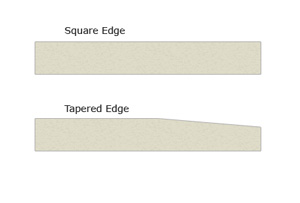There are several different types of plasterboard available for the DIY market, and not all types are suitable for all situations. In most cases, standard square-edged plasterboard will be the only type you need to consider. This guide to the different types of plasterboard will help you work out the correct type to use for the particular task you have in mind.
In This Guide:
– Standard Plasterboard
– Thermal Laminates
– Duplex Plasterboard
– Baseboard
– Impact Board
Standard Plasterboard
 Standard plasterboard is available with both square and tapered edges and usually has one Ivory face which is suitable for direct painting or wallpapering. Use the tapered type if you plan to fill and tape the joints.
Standard plasterboard is available with both square and tapered edges and usually has one Ivory face which is suitable for direct painting or wallpapering. Use the tapered type if you plan to fill and tape the joints.
Either type can be used if you plan to apply a coat of gypsum plaster, but make sure that the tapered edges face inwards. Standard plasterboard is available in a variety of sheet sizes and in thicknesses between 9.5mm and 12.5mm. Any size of standard plasterboard can be used for dot and dab walls, and for affixing to a stud frame.
Thermal Laminates
This is standard plasterboard with a backing layer of some sort of insulation. The insulation layer is usually expanded polystyrene or polyurethane foam, but other types are available.
Thermal laminates, also known as insulated plasterboard, are designed to be used when lining external walls or ceilings, and can even include a water-resistant “vapour check” layer between the board and the insulation for walls where dampness may be a problem.
Thermal Laminates are mostly available in the standard sheet size of 2400mm x 1200mm and range in thickness between 18mm and 65mm. Due to the extra materials used in their construction, thermal laminates are considerably more expensive than other types of plasterboard.
Duplex Plasterboard
Also known as Vapour Barrier Board. Duplex Plasterboard is standard plasterboard with a backing of foil to resist water vapour and add some extra insulation. Duplex plasterboard can also be used as a reflective insulator when the foil backing is facing into a cavity.
This type of plasterboard cannot be fixed using adhesive (such as dot and dab fixing), so take this into consideration when choosing it. Duplex plasterboard is available in the standard sheet size, as well as the smaller size of 1800mm x 900mm. Thicknesses range from 9.5mm to 12.5mm.
 Baseboard
Baseboard
Baseboard is generally the cheapest type of plasterboard, having no ivory face and no additional insulation. It is designed for use on walls and especially ceilings where a coat of gypsum plaster is going to be applied. Baseboard comes in a variety of sheet sizes, but is usually only available in the 9.5mm thickness.
Impact Board
Constructed using fibreglass and other additives, Impact Board is designed to be used in areas of high traffic and heavy wear. The additional expense in the manufacturing stage translates to a far higher price than standard plasterboard, and as such impact board is not often used in domestic situations.
Fire-Resistant Plasterboard
Fire-resistant plasterboard, like Impact Board, is made using a mix of materials such as glass fibre to make it more resistant to fire. Even the thinnest type of fire-resistant board should give up to an hour’s protection from fire.
Plasterboard FAQ
What is the Standard Size of Plasterboard Sheets?
- 1220mm x 900mm
- 1800mm x 900mm
- 2700mm x 1200mm
- 3000mm x 1200mm
- 3600mm x 1200mm
- 2400mm x 900mm
- 2500mm x 1200mm
- 2400mm x 1200mm


 Baseboard
Baseboard




